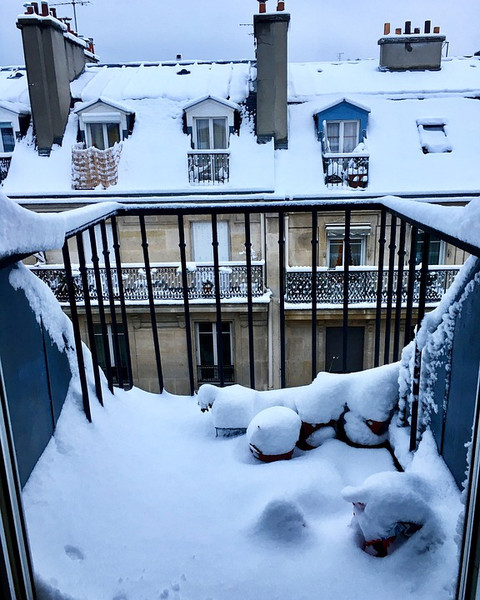Iron Railings & Balconies in the Winter.
Oct 3rd 2022
Winter is slowly creeping up on us, winter can be one of the toughest seasons to deal with. Historically speaking mankind has always had to plan around the wintertime, be it for warmth or resources. In the 20th century however, we tend to run into a different set of issues in relation to the wintertime struggles of the past, one of which we'll be looking at closely is the problems that winter can bring you when you're using one of our beautiful Iron Railings, Iron Balconies or Deck Railings.
For older adults, slips and falls on stairs are a leading cause of accidental death, and even for younger people, stairs are often linked to falls. Pile some ice and snow on the issue and there’s an even higher likelihood of taking a tumble on your stairs during the winter. That’s why you’ll want to make sure that your stair railing is secure and durable.
The Problems That Winter Brings

One of the main home maintenance headaches you'll experience regarding will probably be the erosive and destructive effects that railings can experience when exposed to ice and salt. If a blanket of snow and ice builds up on your Iron Balcony, that is an accident waiting to happen.
The salt we use for deicing roadways and sidewalks can cause accelerated corrosion and rust in metal railings, and water from melted snow and ice can get into your stair’s hardware and corrode the components.
When it comes to Iron Balconies with a wood platform, water from the snow and ice can seep into the small crevices in the wood and then freeze and expand, creating larger cracks which will only get larger and larger over the course of the winter. This is often an issue in states that are both rural and cold in nature such as Wisconsin.
Winter can also bring other, less critical problems, like making certain types of railings unpleasant to grab onto. If you’re avoiding holding on to your stair railings during the winter because they’re so cold, those railings aren’t able to do their job of keeping you safe on the stairs.
How do winter conditions affect stair railings?
While not all stairs are required to have railings (a set of stairs with fewer than 4 risers is not required by code to have a handrail), in climates with severe winters, it’s wise to install railings on all outdoor stairs. This can help those with less mobility around you to traverse your home or workplace more safely. However, in the wintertime this can prove to work against you by turning your beautiful Iron railing into a slippery trap for an unsuspecting guest.
This is especially true if you’re older or have elderly relatives living with you, since falls and slips have the potential to be much more dangerous to seniors. In fact, a large number of stair-related injuries are associated with stairs having just one or two steps.
Choosing a Material for Your Cold Climate-Friendly Railing
When it comes to choosing a material for your stair railing that will look attractive and stay strong no matter what winter brings, there are a few good options, though each has its own benefits and drawbacks. Some railing and baluster materials offer conveniences in terms of longevity and maintenance while others may exhibit a one-of-a-kind look.
- High-quality metal stair railings have the advantage of being extremely long-lasting and durable no matter how hard the winter. Aluminum components are convenient because they won’t rust or corrode easily. Some manufacturers are making iron railings using a special coating that will protect the metal even after it comes in contact with deicing salts. This corrosion-inhibiting finish uses the same process the automotive industry uses to protect vehicle undercarriages from road salt. The main downside to metal stair railings is that they tend to get very cold to the touch.
- While vinyl tends to be durable and does not react with salt, it is affected by the temperature outside, and has the potential to shrink with the cold and expand with the heat. As the temperatures get colder, vinyl also becomes more brittle and less flexible. This aspect doesn’t make vinyl components “fragile” necessarily, but it does slightly increase the chances of damage under impact.
- Wood is an all-time classic because of its low price point and versatility when it comes to style. It also has the benefit of not getting too cold during the winter—you won’t shy away from grabbing onto a wooden railing when it’s -7°F outside. But it has one major drawback: it decays, and ignoring maintenance will almost guarantee that it will need to be replaced at some point in your life. Harsh winters can speed this process up, since ice and snowmelt tend to soak into the wood during the winter. This can also cause the wood to warp if it is not sealed. Don’t forget about freezing water, either. When water gets into crevices and then freezes, it will expand, forcefully separating the material it’s in. If this process can break apart boulders, then your wooden railing posts aren’t going to stand a chance. Wood can last many years even in a cold climate, but it requires regular sealing, maintenance, and inspection.
- Balconies will last a very long time. They do not react easily with salt and are not likely to rust, especially when made with a high-quality, marine-grade stainless steel. One drawback to cable iron balconies is that they have a very open forefront and will not block wind or snow at all. This may be a consideration for those living in a very cold climate.
